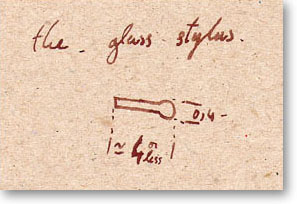
Version: Jan 20, 2004
 |
|
Version: Jan 20, 2004 |
by Henri Chamoux, 1998
You have just broken a glass, have you ? Wonderful! This is an unexpected opportunity to make a two minute cylinder stylus. To do so, you need some broken glass (or crystal), and an incandescent burner. If you have a gas cooker, go to the kitchen. In a rag, take one piece of broken glass in each hand, and put the two sharp edges of glass into the blue part of the flame. After a few seconds, they both turn light red and melt a little. At that moment, make the two parts touch each other, and mix the hot pasty substance. Don't worry, it will not drip, your flame is not strong enough for that. As soon as you obtain a light red-orange colour, remove your two broken pieces thus glued together and pull them promptly by opening your arms, until you obtain a glass wire of 30 to 50 cm long. It will cool rapidly, and you will be able to break the major part of this wire from your two broken pieces of glass. If you have just turned off the gas, light it again, and throw one end of your glass wire into the flame. After which, as by magic, you will obtain a small marble, or bead, perfectly polished, and extremely recommended to read cylinders. You should have a micrometer to control the diameter. Old phonographs had glass or sapphire styli of a diameter of 0.8 mm. But this size was meant for heavy phonograph tone arms. For a lighter pressure, you have to use smaller diameters. I have discovered that the best diameters range from 0.2 to 0.4 mm depending on the type of cylinders: engraved or moulded, brand new or scratchy. With your glass wire, you should be able to make dozens of marbles, so that is really inexpensive. |

| Leave 3 or 4 mm of wire attached to the bead so that you
can glue it to an old cantilever for a standard cartridge. On an inverted
phase stereo cartridge, it provides very good reading results.
|


| The diamond is fixed to a little metallic shaft, the cantilever. So removing it is a delicate operation. Straight out you can break it with a tiny nippers. But it can be detrimental to this so important metallic cantilever that bears, as you certainly know, a small magnet that has to move between the coils of your cartridge. For myself, I don't systematically remove the diamond. I glue my glass on it and it works fine. I use cyanolacrilate glue, like cyanolit or superglue. You need only a very very very small amount of it so that it does not flow on your 2 minute stylus. Note that I use to keep my bead with 2 millimeters of the glass wire attached. |


| Write to Henri Chamoux: | ||
